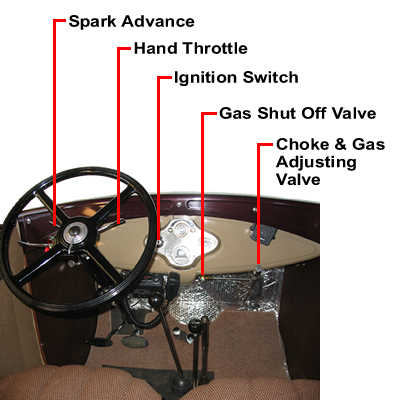Here is one way to check if the engine timing is about where it should be.
Using Carburetor to Check Engine Timing

- Increase engine speed to twice that of idle RPM by pulling down the throttle lever at the steering column.
- Gradually open the gas adjusting valve 1/2 to 1 full turn. The engine should start to run richly, and some smoking at the exhaust may occur. This verifies that the fuel passage, regulated by the Gas Adjusting Valve, is open. Turn the GAV clockwise until the engine RPM returns to where it was previously
- Slowly pull the spark lever down. Engine RPM will increase up to a point. When the maximum RPM is achieved, note this as the position where you will want to place the lever for normal driving purposes.
- Raise the throttle lever up to the top of its travel. The engine should idle smoothly. With the spark lever still in its "ideal" position for everyday driving, go around the car to the carburetor and ram the accelerator control rod (i.e., from the accelerator linkage) forward. The engine should accelerate to maximum speed within about two seconds if the engine timing is correct. Don't hold the accelerator rod in this forward position for more than a few seconds, because you could damage your engine. If the engine accelerates smoothly and without stumbling, your idle and ignition settings are correct.
- If acceleration of engine speed is slow or sluggish, ignition timing is probably somewhat retarded. Move the spark rod up to the top of its travel, and adjust the timing. Once the timing has been adjusted, restart the engine, pull down the throttle rod until engine RPM is twice idle RPM, and return to step 3.